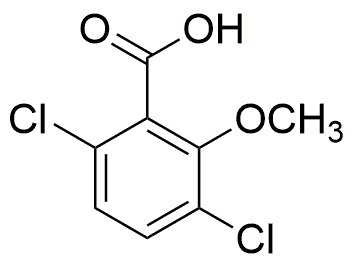Dicamba is widely utilized in research focused on:
- Agricultural Herbicide: Primarily used to control broadleaf weeds in various crops, dicamba is effective in maintaining crop yield and quality, especially in soybean and corn production.
- Environmental Research: Its behavior in soil and water is studied to understand its environmental impact, helping researchers develop better management practices for herbicide application.
- Plant Biology Studies: Researchers use dicamba to investigate plant growth responses and resistance mechanisms, providing insights into plant physiology and genetics.
- Integrated Pest Management (IPM): Dicamba is part of IPM strategies, allowing for more sustainable agricultural practices by reducing reliance on multiple herbicides and promoting crop rotation.
- Development of New Formulations: The chemical serves as a model for developing new herbicide formulations that enhance efficacy and reduce environmental risks, benefiting the agrochemical industry.
Informations générales
Propriétés
Sécurité et réglementation
Applications
Dicamba is widely utilized in research focused on:
- Agricultural Herbicide: Primarily used to control broadleaf weeds in various crops, dicamba is effective in maintaining crop yield and quality, especially in soybean and corn production.
- Environmental Research: Its behavior in soil and water is studied to understand its environmental impact, helping researchers develop better management practices for herbicide application.
- Plant Biology Studies: Researchers use dicamba to investigate plant growth responses and resistance mechanisms, providing insights into plant physiology and genetics.
- Integrated Pest Management (IPM): Dicamba is part of IPM strategies, allowing for more sustainable agricultural practices by reducing reliance on multiple herbicides and promoting crop rotation.
- Development of New Formulations: The chemical serves as a model for developing new herbicide formulations that enhance efficacy and reduce environmental risks, benefiting the agrochemical industry.
Documents
Fiches de données de sécurité (FDS)
La FDS fournit des informations de sécurité complètes sur la manipulation, le stockage et l’élimination du produit.
Spécifications du produit (PS)
Le PS fournit une description complète des propriétés du produit, notamment sa composition chimique, son état physique, sa pureté et les exigences de stockage. Il détaille également les plages de qualité acceptables et les applications prévues du produit.
Certificats d'analyse (COA)
Recherchez des certificats d'analyse (COA) en saisissant le numéro de lot du produit. Les numéros de lot et de lot se trouvent sur l'étiquette d'un produit, après les mots « Lot » ou « Lot de fabrication ».
Numéro de catalogue
Numéro de lot/série
Certificats d'origine (COO)
Ce certificat d'exploitation confirme le pays dans lequel le produit a été fabriqué, et détaille également les matériaux et composants utilisés et s'il est issu de sources naturelles, synthétiques ou autres sources spécifiques. Ce certificat peut être requis pour les douanes, le commerce et la conformité réglementaire.
Numéro de catalogue
Numéro de lot/série
Fiches de données de sécurité (FDS)
La FDS fournit des informations de sécurité complètes sur la manipulation, le stockage et l’élimination du produit.
DownloadSpécifications du produit (PS)
Le PS fournit une description complète des propriétés du produit, notamment sa composition chimique, son état physique, sa pureté et les exigences de stockage. Il détaille également les plages de qualité acceptables et les applications prévues du produit.
DownloadCertificats d'analyse (COA)
Recherchez des certificats d'analyse (COA) en saisissant le numéro de lot du produit. Les numéros de lot et de lot se trouvent sur l'étiquette d'un produit, après les mots « Lot » ou « Lot de fabrication ».
Numéro de catalogue
Numéro de lot/série
Certificats d'origine (COO)
Ce certificat d'exploitation confirme le pays dans lequel le produit a été fabriqué, et détaille également les matériaux et composants utilisés et s'il est issu de sources naturelles, synthétiques ou autres sources spécifiques. Ce certificat peut être requis pour les douanes, le commerce et la conformité réglementaire.


